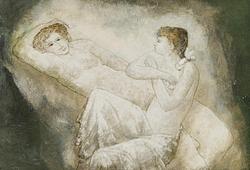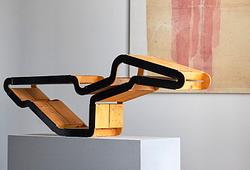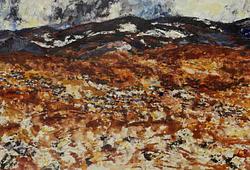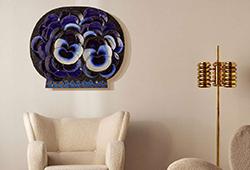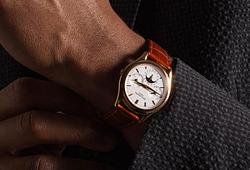Åke Göransson
"Flaska och tillbringare" (Bottle and Jug)
Signed Åke Göranson (with only one S), Probably executed 1923-24. Canvas mounted on panel 40 x 32 cm.
Provenance
Due to Björn Axlund the artist left the painting in Dals-Ed 1924.
Literature
Björn Axlund,, "Färgformen-Åke Göranssons liv och konst", 2002, cat no 3, page 174.
More information
Åke Göransson växte upp tillsammans med sina fyra syskon och modern Hanna. Fadern, Sven Göransson dog ung vid 35-års ålder i en svår njursjukdom, då Åke var endast 1 år. Hanna Göransson fick först försörja sig och de fyra bröderna som hemsömmerska, men blev 1912 anställd som väverska vid Almedahls Fabriker i Göteborg. Deras enkla bostad låg i stadsdelen Getebergsäng, ett gammalt industrisamhälle med rötter i tidigt 1800-tal. Efter 3 år flyttade familjen till Landala, en charmig, men fattig kåkstad där barnfamiljer med 10-12 barn trängdes i enrummare. Åke hade tidigt haft ett kortare sommarjobb hos en frisör i Getebergsäng, så efter skolan 1915 fick han anställning som tvålpojke i Helmer Lundgrens raksalong på Vasagatan. Åke fick slita hårt, från morgon till kväll och rasterna var få. Han avancerade snabbt och i hans betyg står ordet ”ärlig” understruket. 1917 blev han frisörbiträde och efter 3 år fullärd frisör. Vid sidan av sin hårda arbetstillvaro bildade han sig med konsthistoria och plöjde bibliotekshyllor med stor aptit. Speciellt intresserade han sig för förnuftsdyrkaren Herbert Spencers teorier och formulerade sin egen stoiska sanning med oden ”Skall man skapa verklig konst måste man söka stå ovan sitt eget öde”. Mest fokuserade han dock på konsten och lärde sig allt om färglära och en hel del konstteori. Han tecknade flitigt nästan jämt och en och annan akvarell med landskapsmotiv tillkom under söndagspromenaderna. 1920-21 gick han igenom en ”fullständig kurs i frihandsteckning via korrespondensstudier på Hermods och fortsatte sen med ”kurs i oljemåleri”, parallellt skötte han sitt arbete som frisör. Sommaren 1923 flyttar han till det lilla samhället Dals-Ed där han fick plats hos barberaren John Gustafson. I lilla "Ed" rådde ett lugnare tempo och Åke fick mer tid för måleri. Gustafsons hälsa vacklade, han var sjuklig och nervklen och långa perioder fick Åke den tunga arbetsbördan för den enda frisersalongen i Ed. I Ed träffade han också Inga, född i Norge av svenska föräldrar. Inga blev hans enda kärlek och mor till hans barn. Når Åke och Inga lämnade lilla Ed för att flytta till Göteborg lämnade han kvar några målningar hos Gustafson som var olycklig över att mista sin frisör och vän. Björn Axlund skriver i sin bok ”Färgformen-Åke Göranssons liv och konst” att ”Flaska och tillbringare” blev kvar i Dals-Ed 1924. Vad som hände stillebenet därefter är okänt fram till att nuvarande ägares mormors syster förvärvade målningen "någon gång på 1960-talet".
Designer
Åke Göransson was born in Veddige in Halland 1902. His parents were shoemaker Sven GÖransson and his wife Hanna. Sven Göransson died when Åke was only three years od and thus his mother Hanna came to play a big role in Åke's life, both as a breadwinner and a support system. Åke eventually starts working as a barbor, drawing and painting on the side for Hermods. He eventually got engaged to Inga Andersson. In 1924, Åke becomes a part time student at Valand's art school, but his tricky economic situation forces him to work halftime as a barbor. He became somewhat of a hermit, but at school he spent time with other artists who railed around their teacher Tor Bjurström. After a short period of stability begins the tendancies of poor mental health show itself. From 1932 his health deteriorates, he is deemed mentally insane, and he finds himself to leave his mothers apartment in Landala. It is from this period that the most interesting and intensive paintings were made. Torn from the world, Göransson continuously paints new versions of his view of Egnahemsvägenin Landala, interiors from the studio flat, with Hannah often lurking in the photographs. His friends from his studies find themselves intranced by his canvas paintings, and his friend Ivan Ivarson convinces Göransson to lend three artworks to the collection exhibition of 1933 at Paletten in Gothenburg. The exhibition is greatly received and brings national fame to Göransson's art. However, he is simultaneously experiencing an internal crisis and depression, and it becomes impossible for im to continue painting, and thus cannot continue to support his wife and daughter Ingrid. After this his artworks fluctuates with his state of mind, the dark is contrasted with the light, light with darkness. In the long run, his mother can no longer continue to support him with all of the art supplies he needs, and he instead begins to paint over old canvases. In 1937 Göransson was finally emitted into Gothenburgs new mental hospital. He was in terrible form, both mentally and physically, since he suffered from tuberkulosis, weighed only 48 kilos, and had full fledged schizophrenia. He remained at the hospital until his death in 1942.
Åke Göransson's artistic career would likely have faded into obscurity if Arne Stubelius had not made a spontaneous visit to Göransson's mother, Hanna, one summer day in 1940.Stublius worked with monographs like Ivan Ivarson and wanted to verify some facts. One time, Stublius asked if there were any more of Göransson's art left in the home. Göransson's mother asked her son to mobe off the sofa, where upon opening the sofa cover, they found the home of Göransson's art. This marked the beginning of Åke Göransson’s artistic career being brought into the spotlight. Through purchases, Gösta Stenman enabled the rescue of the works. They were restored, mounted on panels, and framed. The exhibition at Modern Konst i Hemmiljö on Strandvägen in Stockholm in 1941 was received very positively and marked the start of significant attention towards Göransson’s work. Only a few paintings were created in the hospital the following year before Åke Göransson passed away from mental exhaustion and tuberculosis in 1942.
Read more



